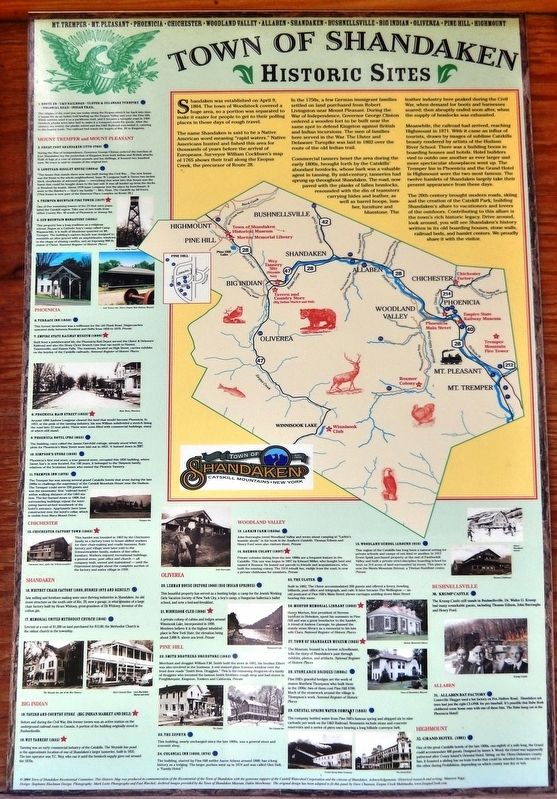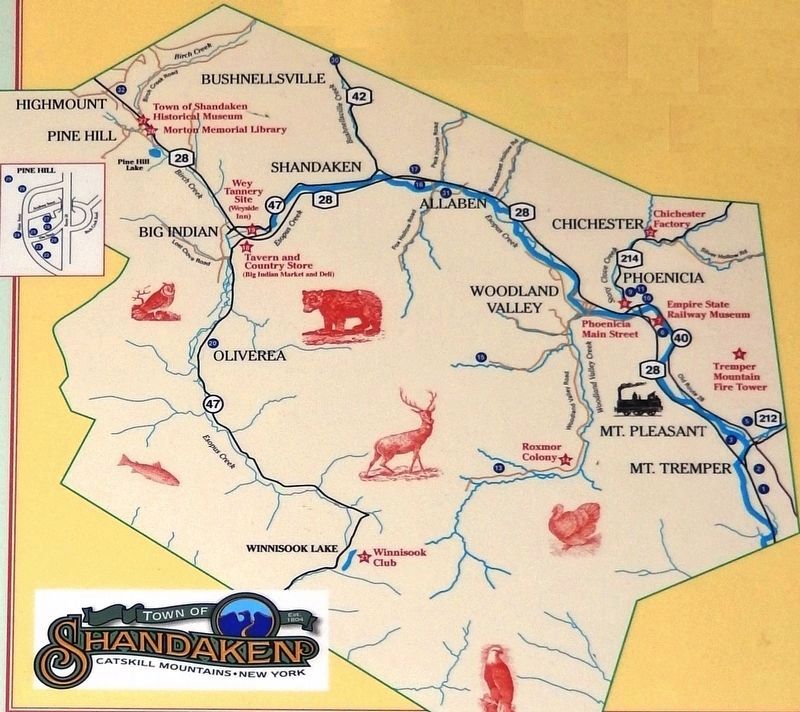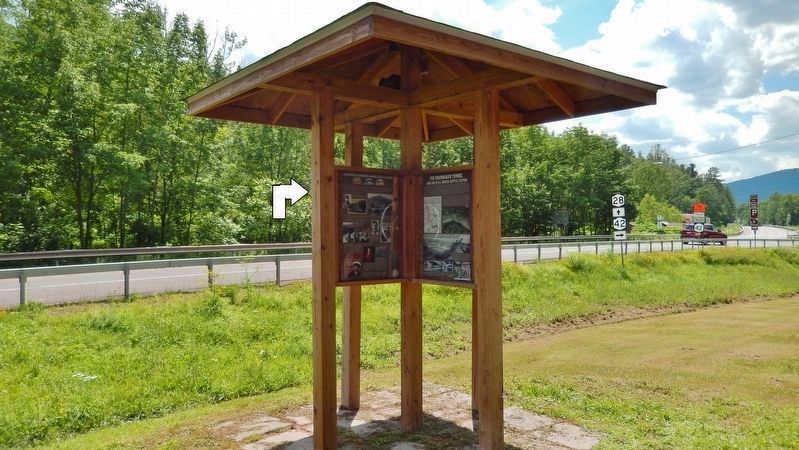Shandaken in Ulster County, New York — The American Northeast (Mid-Atlantic)
Town of Shandaken Historic Sites
The name Shandaken is said to be a Native American word meaning "rapid waters." Native Americans hunted and fished this area for thousands of years before the arrival of Europeans. Surveyor William Cockburn's map of 1765 shows their trail along the Esopus Creek, the precursor of Route 28.
In the 1750s, a few German immigrant families settled on land purchased from Robert Livingston near Mount Pleasant. During the War of Independence, Governor George Clinton ordered a wooden fort to be built near the same spot to defend Kingston against British and Indian incursions. The men of families here served in the War. The Ulster and Delaware Turnpike was laid in 1802 over the route of the old Indian trail.
Commercial tanners beset the area during the early 1800s, brought forth by the Catskills' abundant hemlocks, whose bark was a valuable agent in tanning. By mid-century, tanneries had sprung up throughout Shandaken. The road, now paved with the planks of fallen hemlocks, resounded with the din of teamsters carrying hides and leather, as well as barrel hoops, lumber, furniture and bluestone. The leather industry here peaked during the Civil War, when demand for boots and harnesses soared; then abruptly ended soon after, when the supply of hemlocks was exhausted.
Meanwhile, the railroad had arrived, reaching Highmount in 1871. With it came an influx of tourists, drawn by images of sublime Catskills beauty rendered by artists of the Hudson River School. There was a building boom in boarding houses and hotels. Hotel builders vied to outdo one another as ever larger and more spectacular showplaces went up. The Tremper Inn in Phoenicia and the Grand Hotel in Highmount were the two most famous. The twelve hamlets of Shandaken largely take their present appearance from these days.
The 20th century brought modern roads, skiing and the creation of the Catskill Park, building Shandaken's allure to vacationers and lovers of the outdoors. Contributing to this allure is the town's rich historic legacy. Drive around, look around, you will see Shandaken's history written in its old boarding houses, stone walls, railroad beds, and hamlet centers. We proudly share it with the visitor.
1. Route 28 • U&D Railroad • Ulster & Delaware Turnpike • Colonial Road • Indian Trail
The origins of the road you see today along the Esopus stretch far back into time. It began life as an Indian trail leading up the Esopus Valley and over the Pine Hill. White settlers used it as a packhorse trail, and It became a turnpike road in 1802. Hemlock planks were later laid to make it a transport route for goods. After the tannery era ended, the planks rotted and the U&D Railroad succeeded it, catering to the tourist trade. The railroad bed winds the length of Rte. 28 to Kingston.
2. Great Fort Shandaken (1779-1783)
During the War of Independence, Governor George Clinton ordered the erection of Fort Shandaken for the protection of Kingston from both Indian and British attacks. Built of logs at a cost of sixteen pounds and ten shillings, it housed two hundred men. No trace is said to remain of the original fort.
3. Longyear-Riseley House (1860s)
”The house that stands there now was built during the Civil War… The new house was the finest in the whole neighborhood. Isaac W. Longyear built it. Doors two inches thick, doorknobs of mirrored glass — everything that went into that house was the finest that could be bought down to the last nail. It was all hauled up from the docks at Rondout by teams. About 1878 Isaac Longyear lost the place by foreclosure. It went to the Riseley's — that's my family." — Mrs. Hoyt, The Catskills by Alf Evers. (This house is now part of the Emerson Place complex on Route 28.)
4. Tremper Mountain Fire Tower (1917)
One of five remaining towers of the
23 that once populated the Catskill region. Take one of two trails from either County Rte. 40 south of Phoenicia or Jessup Rd.
5. Zen Mountain Monastery (1920s)
This property has a long tradition as a religious retreat. Begun as a Catholic boy's camp called Camp Wapanachki, it is built of bluestone quarried on Mt. Tremper. The building's eastern façade was designed to resemble an altar graced with an amphitheater, windows in the shape of shining candles, and an imposing 800 lb. statue of Christ. National Register of Historic Places
6. Terrace Inn (1850)
This former farmhouse was a tollhouse for the old Plank Road. Stagecoaches operated daily between Rondout and Delhi from 1850 to 1870. Private
7. Empire State Railway Museum (1899)
Built from a prefabricated kit, the Phoenicia Rail Depot served the Ulster & Delaware Railroad and also the Stony Clove Branch Line that ran north to Hunter, Tannersville, and Haines Falls. The museum, located on High Street, carries exhibits on the heyday of the Catskills railroads. National Register of Historic Places
8. Phoenicia Main Street (1853)
Around 1800 Andrew Longyear cleared the land that would become Phoenicia. In 1853, at the peak of the tanning industry, his son William subdivided a stretch lining the road into 22 neat plots. These were soon filled with commercial buildings, many of which still stand.
9. Phoenicia Hotel (Pre-1853)
The building, once called the James Fairchild cottage, already stood when the plots for Phoenicia's Main Street were laid out in 1853. It burned down in 2007.
10. Simpson’s Store (1856)
Phoenicia's first real store, a true general store, occupied this 1856 building, where Sweet Sue's is now located. For 100 years, it belonged to the Simpson family, relatives of the Scotsman James who owned the Phoenix Tannery.
11. Tremper Inn (1878)
The Tremper Inn was among several grand Catskills hotels that arose during the late 1800s to challenge the supremacy of the Catskill Mountain House near the Hudson. The Tremper could serve 250 guests and was the mountains' first "railroad hotel," within walking distance of the U&D station. The Inn burned down in 1908, but surrounding buildings repeat the interesting barrel-arched woodwork of the hotel's entrance. Apartments have been constructed over the hotel's cellar, which is visible from Mary Mount Drive.
12. Chichester Factory Town (1863)
This hamlet was founded in 1863 by the Chichester family as a factory town to house skilled workers for their chair-making and cradle business. Both factory and village were later sold to the Schwarzwaelder family, makers of fine office furniture. Workers enjoyed recreational buildings, a general store, post office and church — all company built, owned and maintained — until the Depression brought about the complete auction of the factory and entire village in 1939.
13. Larkin Farm (1850s)
John Burroughs loved Woodland Valley and wrote about camping at “Larkin's humble abode” in his book In the Southern Catskills. Thomas Edison and Henry Ford were also visitors there. Private
14. Roxmor Colony (1897)
Private colonies dating from the late 1800s are a frequent feature in the Catskills. This one was begun in 1897 by Edward Miller, who bought land and named it Roxmor. He leased out parcels to friends and acquaintances, who built the existing colony. The 1914 rebuilt Inn, visible from the road, is now a private clubhouse for members. Private
15. Woodland School (around 1913)
This region of the Catskills has long been a natural setting for private schools and camps of one kind or another. In 1913 Erwin Spink purchased property at the end of Pantherkill Valley and built a private strict-discipline boarding school for boys on 314 acres of land surrounded by forest. This place is now the Menla Mountain Retreat, a Tibetan Buddhist center. Private
16. Whitney Chair Factory (1869, burned 1872 and rebuilt)
Saw milling and furniture making were once thriving industries in Shandaken. An old stone structure on the south side of Rte. 28, now a garage, is what remains of a large chair factory built by Hiram Whitney, great-grandson of Eli Whitney, inventor of the cotton gin.
17. Memorial United Methodist Church (1846)
Erected at a cost of $1,200 on land purchased for $12.00, the Methodist Church is the oldest church in the township.
18. Tavern and Country Store (Big Indian Market and Deli)
Before and during the Civil War, this former tavern was an active station on the underground railroad route to Canada. A portion of the building originally stood in Bushnellsville.
19. Wey Tannery (1835)
Tanning was an early commercial industry of the Catskills. The Weyside Inn pond is the approximate location of one of Shandaken's larger tanneries, built in 1835. The last operator was T.C. Wey, who ran it until the hemlock supply gave out around the 1870s.
20. Lehman House (before 1900) (Big Indian Springs)
This beautiful property has served as a hunting lodge, a camp for the Jewish Working Girls Vacation Society of New York City, a boy's camp, a Hungarian ballerina's ballet school, and now a bed-and-breakfast.
21. Winnisook Club (1890)
A private colony of cabins and lodges around Winnisook Lake, incorporated in 1890. Members believe it is the highest inhabited place in New York State, the elevation being about 3,000 ft. above sea level. Private
22. Smith Brothers Drugstore (1882)
Merchant and druggist William F.M. Smith built the store in 1882, his brother Elbert was also involved in the business. A red stained glass transom window over the front door reads “Smith Bros. Druggists.” This is the remaining drugstore of a family of druggists who invented the famous Smith Brothers cough drop and had stores in Poughkeepsie, Kingston, Yonkers and California. Private
23. The Zephyr
This building, nearly unchanged since the late 1800s, was a general store and souvenir shop.
24. Colonial Inn (1800, 1874)
The building, started by Pine Hill settler Aaron Adams around 1800, has a long history as a lodging. The larger portion went up in 1874 and was called Glen Hall, a “Family Hotel.”
25. The Ulster
Built in 1882, The Ulster accommodated 200 guests and offered a livery, bowling, billiards, post office and telegraph, and café. It later became The Wellington — an old postcard of Pine Hill's Main Street shows carriages ambling down Main Street bearing this name.
26. Morton Memorial Library (1903)
Henry Morton, first president of Stevens Institute in Hoboken, spent his summers in Pine Hill and was a great benefactor to the hamlet. A friend of Andrew Carnegie, he planned the stately stone library as a memorial to his late wife Clara. National Register of Historic Places
27. Town of Shandaken Museum (1925)
The Museum, housed in a former schoolhouse, tells the story of Shandaken's past through exhibits, photos, and artifacts. National Register of Historic Places
28. Stone Arch Bridges (1890s)
Pine Hill's graceful bridges are the work of mason Matthew Thompson who built them in the 1890s: two of them cost Pine Hill $700. Much of the stonework around the village is Thompson's work. National Register of Historic Places
29. Crystal Spring Water Company (1885)
The company bottled water from Pine Hill's famous spring and shipped six to nine carloads per week on the U&D Railroad. Remnants include stone and concrete reservoirs and a series of piers once bearing a long hillside conveyor belt.
30. Krump Castle
The Krump Castle still stands in Bushnellsville. Dr. Walter G. Krump had many remarkable guests, including Thomas Edison, John Burroughs and Henry Ford.
31. Allaben Bat Factory
Louisville Slugger used a bat factory on Fox Hollow Road. Shandaken ash trees had just the right CLONK for pro baseball. It's possible that Babe Ruth clobbered some home runs with one of these bats. The Babe hung out at the Phoenicia Hotel!
32. Grand Hotel (1881)
One of the great Catskills hotels of the late 1800s, one-eighth of a mile long, the Grand could accommodate 400 guests. Designed by James A. Wood, the Grand was supposedly patterned after Coney Island's Oriental Hotel. Sitting on the Ulster-Delaware county line, it boasted a sliding bar on train tracks that could be wheeled from one end to the other during Prohibition, depending on which county was dry or wet.
Topics. This historical marker is listed in these topic lists: Industry & Commerce • Native Americans • Roads & Vehicles • Settlements & Settlers. A significant historical date for this entry is April 9, 1804.
Location. 42° 7.17′ N, 74° 23.56′ W. Marker is in Shandaken, New York, in Ulster County. Marker can be reached from New York State Route 28 just west of Ruthenbeck Road, on the right when traveling west. Marker is mounted in a roadside interpretive kiosk, beside a pull-out on the south side of Ruthenbeck Development Road. Touch for map. Marker is in this post office area: Shandaken NY 12480, United States of America. Touch for directions.
Other nearby markers. At least 8 other markers are within 5 miles of this marker, measured as the crow flies. The History of Shandaken, Bushnellsville & Allaben (here, next to this marker); The Shandaken Tunnel and the N.Y.C. Water Supply System (here, next to this marker); Catskill Water Supply System (approx. 1½ miles away); History of Big Indian and Oliverea (approx. 3 miles away); State Land (approx. 3.2 miles away); Chichester (approx. 4½ miles away); Belleayre Mountain Ski Center (approx. 4.6 miles away); History of Pine Hill and Highmount (approx. 4.6 miles away). Touch for a list and map of all markers in Shandaken.
Credits. This page was last revised on March 29, 2020. It was originally submitted on March 29, 2020, by Cosmos Mariner of Cape Canaveral, Florida. This page has been viewed 928 times since then and 114 times this year. Photos: 1, 2, 3. submitted on March 29, 2020, by Cosmos Mariner of Cape Canaveral, Florida.


